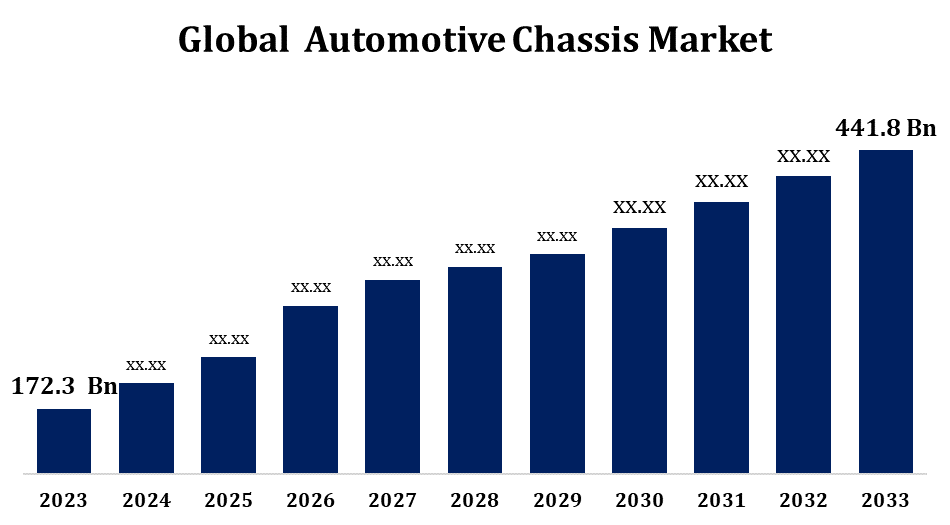Global Automotive Chassis Market Size, Share, and COVID-19 Impact Analysis, By Vehicle Type (Passenger Cars, Commercial Vehicles, and Electric Vehicles), By Chassis Type (Non-Conventional, Conventional, and Modular), and By Region (North America, Europe, Asia-Pacific, Latin America, Middle East, and Africa), Analysis and Forecast 2023 - 2033
Industry: Automotive & TransportationGlobal Automotive Chassis Market Size Forecasts to 2033
- The Global Automotive Chassis Market Size was valued at USD 172.3 Billion in 2023.
- The Market Size is Growing at a CAGR of 9.87% from 2023 to 2033.
- The Worldwide Automotive Chassis Market Size is expected to reach USD 441.8 Billion by 2033.
- Asia Pacific is expected to grow the fastest during the forecast period.

Get more details on this report -
The Global Automotive Chassis Market Size is Expected to reach USD 441.8 Billion by 2033, at a CAGR of 9.87% during the forecast period 2023 to 2033.
The automotive chassis market is a crucial segment within the automotive industry, responsible for the structural framework that supports and houses various vehicle components. This market has seen significant growth driven by the increasing demand for lightweight, durable, and fuel-efficient vehicles. The adoption of advanced materials such as aluminum, carbon fiber, and high-strength steel is rising, contributing to reduced vehicle weight and enhanced performance. Additionally, the shift toward electric vehicles (EVs) is propelling innovation in chassis design to accommodate battery packs and improve energy efficiency. With evolving safety standards and a growing focus on sustainability, manufacturers are focusing on producing chassis that offer better crash protection, rigidity, and recyclability. The global automotive chassis market is expected to expand as vehicle production volumes increase and consumer preferences shift towards environmentally friendly and high-performance vehicles.
Automotive Chassis Market Value Chain Analysis
The automotive chassis market value chain involves several key stages, from raw material procurement to end-user delivery. The process begins with the sourcing of raw materials such as steel, aluminum, and composite materials, which are then processed into chassis components. These materials are supplied to component manufacturers, who design and produce parts like the frame, suspension, and axles. The components are then assembled by vehicle manufacturers, who integrate them into the vehicle’s structure. Post-production, the chassis undergoes rigorous testing for safety, durability, and performance. Distribution involves delivering finished vehicles to dealerships and customers. Key players in the value chain include raw material suppliers, component manufacturers, vehicle assemblers, and distribution networks. The entire chain is influenced by advancements in material science, manufacturing processes, and consumer demand for lightweight, fuel-efficient, and safe vehicles.
-
Automotive Chassis Market Opportunity Analysis
The automotive chassis market offers significant growth prospects driven by key industry trends and technological innovations. The increasing demand for lightweight vehicles to enhance fuel efficiency and reduce emissions is leading manufacturers to adopt advanced materials like aluminum, carbon fiber, and high-strength steel. This trend is especially prominent in the electric vehicle (EV) sector, where chassis designs must accommodate larger battery packs and optimize energy use. Additionally, modular chassis platforms are gaining popularity due to their scalability and flexibility for various vehicle types, reducing production costs and time-to-market. Strict safety regulations and consumer demand for improved vehicle performance are also driving innovations in chassis design, such as enhanced crashworthiness and structural integrity. With rapid growth in regions like Asia-Pacific, companies investing in lightweight materials, modular designs, and safety innovations are well-positioned to capitalize on emerging opportunities.
Automotive Chassis Market Report Coverage
| Report Coverage | Details |
|---|---|
| Base Year: | 2023 |
| Market Size in 2023: | USD 172.3 Billion |
| Forecast Period: | 2023-2033 |
| Forecast Period CAGR 2023-2033 : | 9.87% |
| 2033 Value Projection: | USD 441.8 Billion |
| Historical Data for: | 2019-2022 |
| No. of Pages: | 244 |
| Tables, Charts & Figures: | 125 |
| Segments covered: | By Vehicle Type, By Chassis Type, By Region and COVID-19 Impact Analysis |
| Companies covered:: | Continental, ZF Friedrichshafen, Magna, Schaeffler, Aisin Seiki, CIE Automotive, Benteler, Hyundai Mobis, Ligier Automotive, Gestamp, and others key vendors. |
| Pitfalls & Challenges: | COVID-19 Empact, Challenge, Future, Growth, & Analysis. |
Get more details on this report -
Market Dynamics
Automotive Chassis Market Dynamics
Increasing Demand for Advanced Chassis Materials to Drive Market Growth
The growing demand for advanced chassis materials is a key driver of growth in the automotive chassis market. As consumers and manufacturers prioritize fuel efficiency, lower emissions, and improved vehicle performance, the use of lightweight materials such as aluminum, carbon fiber, and high-strength steel has become more prevalent. These materials not only reduce the overall weight of vehicles but also enhance their structural integrity, safety, and durability. The shift towards electric vehicles (EVs) has further accelerated this trend, as EVs require lightweight, energy-efficient chassis designs to accommodate larger battery packs. Additionally, advanced materials contribute to better crash protection, increased performance, and longer vehicle lifespans. As manufacturers continue to innovate and adopt these materials, the automotive chassis market is expected to experience significant growth in the coming years.
Restraints & Challenges
One of the primary concerns is the high cost associated with advanced materials such as carbon fiber and aluminum, which are essential for reducing vehicle weight and enhancing performance. While these materials offer numerous benefits, their adoption can increase production costs, limiting affordability for consumers. Additionally, the complex nature of chassis design, especially with the rise of electric vehicles (EVs), demands extensive research and development, which can delay time-to-market and increase manufacturing costs. Moreover, the need to meet stringent safety and environmental regulations further complicates the design and production process. Finally, the global supply chain disruptions and fluctuating raw material prices can impact the availability and cost of key components, adding another layer of uncertainty to the market.
Regional Forecasts

Get more details on this report -
North America Market Statistics
North America is anticipated to dominate the Automotive Chassis Market from 2023 to 2033. The North American automotive chassis market is experiencing steady growth, driven by technological advancements and evolving consumer demands. Key factors influencing this growth include the increasing preference for lightweight, fuel-efficient vehicles, which are pushing manufacturers to adopt advanced materials such as aluminum alloys and carbon fiber composites. Additionally, the rise of electric vehicles (EVs) is driving the development of specialized chassis systems to accommodate larger battery packs and enhance vehicle performance. The region's automotive industry is also focused on improving safety and durability, spurring innovations in chassis design.
Asia Pacific Market Statistics
Asia Pacific is witnessing the fastest market growth between 2023 to 2033. China, India, and Japan are major contributors, benefiting from cost-effective manufacturing, a large labor force, and easy access to raw materials. The demand for lightweight, fuel-efficient vehicles is pushing manufacturers to adopt advanced materials such as aluminum alloys and carbon fiber composites. Additionally, the rise of EVs is driving innovation in chassis design, with a focus on developing modular platforms and enhancing structural integrity to accommodate larger battery packs. As a result, the Asia-Pacific region is expected to continue leading the global automotive chassis market, with sustained growth fueled by technological advancements and evolving consumer preferences.
Segmentation Analysis
Insights by Vehicle Type
The passenger cars segment accounted for the largest market share over the forecast period 2023 to 2033. This segment contributes significantly to market revenue due to high production volumes and premium pricing. Key factors such as urbanization, increasing disposable incomes, and a growing middle class in emerging markets are further boosting demand. Automakers are introducing new models equipped with innovative technologies like fast charging, navigation, voice recognition, and smartphone connectivity. The integration of safety features, such as automatic parking, braking, and lane-keeping assistance, is also contributing to growth. Furthermore, the adoption of lightweight materials and advanced chassis systems is enhancing vehicle performance and fuel efficiency, aligning with consumer preferences for eco-friendly options. This makes the passenger car segment a key driver in the automotive chassis market.
Insights by Chassis Type
The non-conventional segment accounted for the largest market share over the forecast period 2023 to 2033. The rise of EVs is particularly influential, as these vehicles require specialized chassis designs to accommodate larger battery packs, optimize energy efficiency, and ensure structural integrity. As consumers increasingly shift toward sustainable and eco-friendly transportation options, the demand for lightweight, durable, and performance-enhancing chassis materials is rising. Additionally, the growing interest in autonomous vehicles is driving innovation in chassis systems to support advanced sensors, automation technologies, and improved safety features. These vehicles require robust and adaptable chassis platforms to integrate emerging technologies. The non-conventional segment's growth is fueled by technological advancements, evolving regulatory standards, and changing consumer preferences toward alternative mobility solutions.
Recent Market Developments
- In April 2023, Magna International has been selected to manufacture INEOS Automotive's new electric SUV, with production set to commence in 2026 in Graz, Austria. Furthermore, Magna will handle the full engineering of the vehicle.
Competitive Landscape
Major players in the market
- Continental
- ZF Friedrichshafen
- Magna
- Schaeffler
- Aisin Seiki
- CIE Automotive
- Benteler
- Hyundai Mobis
- Ligier Automotive
- Gestamp
Market Segmentation
This study forecasts revenue at global, regional, and country levels from 2023 to 2033.
Automotive Chassis Market, Vehicle Type Analysis
- Passenger Cars
- Commercial Vehicles
- Electric Vehicles
Automotive Chassis Market, Chassis Type Analysis
- Non-Conventional
- Conventional
- Modular
Automotive Chassis Market, Regional Analysis
- North America
- US
- Canada
- Mexico
- Europe
- Germany
- Uk
- France
- Italy
- Spain
- Russia
- Rest of Europe
- Asia Pacific
- China
- Japan
- India
- South Korea
- Australia
- Rest of Asia Pacific
- South America
- Brazil
- Argentina
- Rest of South America
- Middle East & Africa
- UAE
- Saudi Arabia
- Qatar
- South Africa
- Rest of the Middle East & Africa
Frequently Asked Questions (FAQ)
-
1. What is the market size of the Automotive Chassis Market?The global Automotive Chassis Market is expected to grow from USD 172.3 billion in 2023 to USD 441.8 billion by 2033, at a CAGR of 9.87% during the forecast period 2023-2033.
-
2. Who are the key market players of the Automotive Chassis Market?Some of the key market players of the market are Continental, ZF Friedrichshafen, Magna, Schaeffler, Aisin Seiki, CIE Automotive, Benteler, Hyundai Mobis and Ligier Automotive, Gestamp.
-
3. Which segment holds the largest market share?The passenger cars segment holds the largest market share and is going to continue its dominance.
Need help to buy this report?